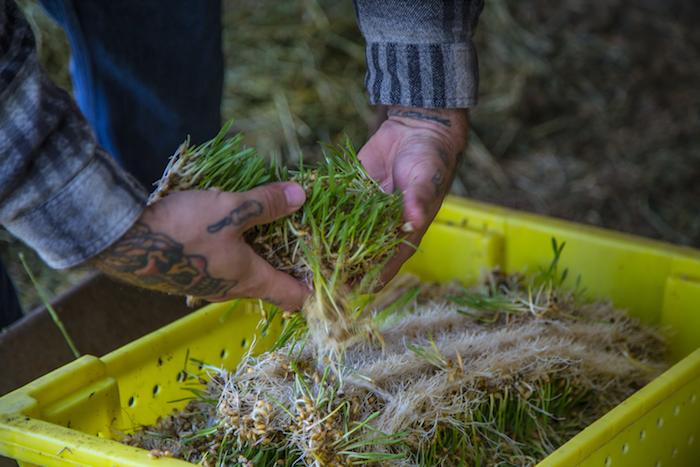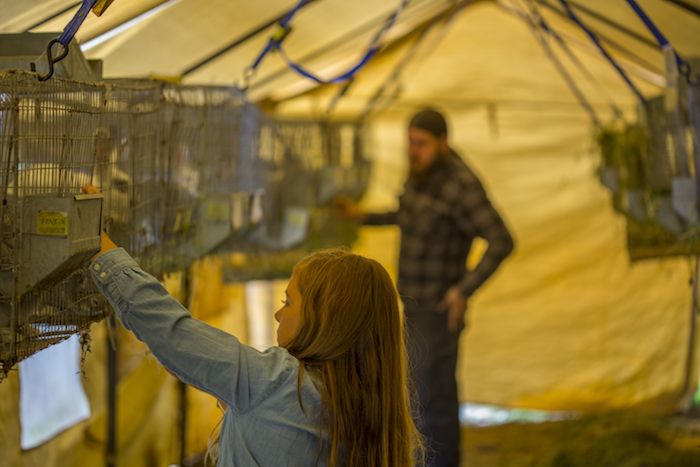A European ancestral staple, rabbit meat is on the comeback—unless it rains.
In 2013, a disease outbreak ravaged the North Bay, and when the dust had settled, Eric Shevchenko’s small farm was in ruins. He had just 40 rabbits left.
But the farmer has recovered and rebuilt his colony. Shevchenko has also moved from his home in Napa County to Sebastopol, where he now has 100 meat rabbits and counting at a small farm named Old World Rabbitry. He is at a pace to sell about 3,000 this year, and he aims to make a living producing and selling this specialty meat to what seems like a burgeoning marketplace.
The demand for rabbit is huge. “I can’t even begin to keep up,” he says.
Neither can OZ Family Farm in Dry Creek Valley, which has a colony of 800 rabbits and sells thousands per year to restaurants and at the twice-weekly Santa Rosa Original Certified Farmers Market held at the Wells Fargo Center. Owner Kelly Osman says rabbit is an easy sell if not an easy animal to produce. While rabbits breed prolifically, they are also finicky.
“They’re very fragile,” she says, explaining that diseases and infections can easily knock them off their feet. They’re also sensitive to stress, Osman says, and mothers subjected to noise or disturbances may abandon their young, costing farmers an entire litter.
Rabbit, a staple meat of our ancestors, has become popular again in California’s culinary society. Rabbit meat tends to be very low in fat and calories and mild in flavor. The environmental impacts of growing rabbits are also considerably less than those of bringing bigger, more conventional livestock species to slaughter. This is because rabbits are exceptionally efficient at converting food material into, well, rabbit. They grow and reproduce prolifically, with a single doe able to generate 300 pounds of meat in a year. The babies, or kits, often come 10 or more to a litter and reach market size in about two months.
“The resources that it takes to produce a pound of beef can produce six pounds of rabbit,” Shevchenko says. “Ecologically, this makes way more sense than growing most beef.”
Osman’s rabbits eat mostly alfalfa, which she says is an environmental win.
“You’re getting a healthier, more sustainable meat [than beef and pork] that’s raised on a food that isn’t competing with people,” Osman says.
Shevchenko’s rabbits eat yucca root, garlic, ginger, flaxseed, and fish oil—an alkaline, low-inflammatory diet that Shevchenko says makes for a better tasting meat and a hardier creature all around.
Rabbits are cute. Shevchenko knows this. “It’s a cute little fuzzy animal,” he says. “People see them as pets.” He says his girlfriend once had a pet rabbit, and he, too, has a soft heart for the animals. He has befriended several of his own rabbits over the years, notably two old breeders named Big Daddy and Denise Hopper that have essentially become family pets.
Unsurprisingly, animal rights activists have given Shevchenko a hard time in the recent past, with aggressive letters and emails. “I feel for these people because I believe in their cause [of animal welfare],” he says.
Shevchenko even practiced veganism for a good part of the 1990s, he says, mainly because he was unable to find what he considered to be ethically reared meat.
Now, he seems to be raising it—but meat isn’t all he sells. To honor the animals, he makes use of nearly everything—even hides and fur and bones, which he sometimes provides to collectors. The organ meats, he says, sell rapidly, and he even uses the blood on occasion—not for making sausage or soup, but for making a sort of a cocktail: He considers a dash of rabbit blood with a shot of grappa to be a tonic.
Shevchenko, a Michigan native with Ukrainian roots, started his rabbit venture in 2010 in Lake County. At the time, he had six animals—American white and American blue rabbits procured from other breeders scattered around the West. He bred the animals selectively, and he grew his colony rapidly. By 2012, he had 150 breeding rabbits and was pacing to sell thousands of meat rabbits per year.
Then, Myxomatosis hit and nearly put Shevchenko out of business. A mosquito-borne virus first observed in the 1950s and once utilized in Australia as a remedy for the island nation’s invasive rabbit plague, the virus moves through the world’s rabbit populations, surfacing now and then with deadly force. Wild rabbits have developed some resistance to the virus, but domesticated breeds can be extremely vulnerable, especially in damp or muggy climates.
As scientists predict a rainy winter, rabbit farmers are a little uneasy. A wet season could prompt another outbreak of Myxomatosis—part of the reason that Osman, who managed to get past the last outbreak mostly unscathed, is in the process of moving the farm from Dry Creek Valley to the rabbit-friendlier climes of Valley Ford. There, she says, cooler weather could mean less mosquito activity.
Shevchenko, too, is nervous about the forecast for rain. However, after his 2012 setback, he selectively bred his animals to rebuild his colony, relying heavily on a breeder named Big Daddy, who survived the outbreak while his kin dropped like flies. While the old male’s vision is failing, his virility isn’t, and Shevchenko says Big Daddy’s genes are now dispersed through much of the colony and may shield his rabbits against another Myxomatosis event.
Indeed, Shevchenko is banking on genetic resistance to the dreaded virus. In fact, he thinks his rabbit farm may now actually be better suited to withstand a disease outbreak, thanks to its bleak history.
“I rebuilt my flock last time using survivors,” he says. “It’s possible the disease just made them stronger.”



